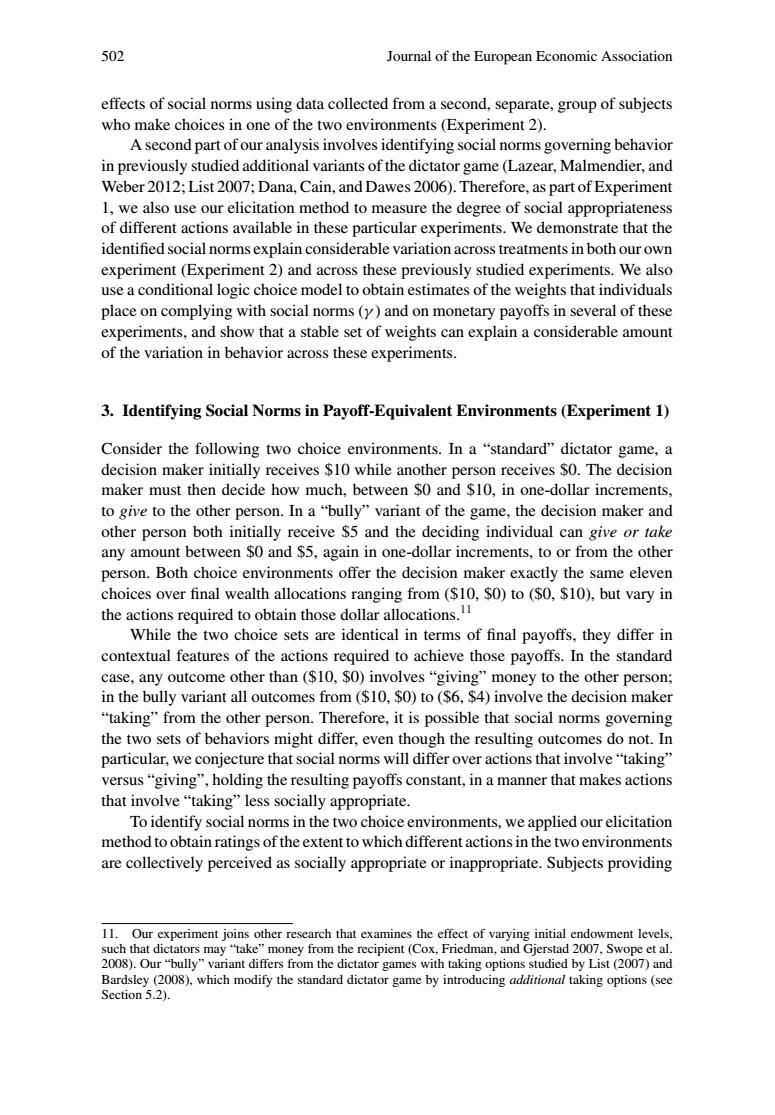正在加载图片...

502 Journal of the European Economic Association effects of social norms using data collected from a second,separate,group of subjects who make choices in one of the ofour analysis involves identifving social norms ment 2) in previously studied additional variants of the dictator game (Lazear.Malmendier.and Weber 2012;List 2007;Dana,Cain,and Dawes 2006).Therefore,as part of Experiment of diffe available in thes r experimen ts We te that the identified social normsexplain considerable variation across treatments in both our owr experiment(Experiment 2)and across these previously studied experiments.We also use a conditional logic choice model to obtain estimates of the weights that individuals place on complying with social norms(y)and on monetary payoffs in several of these showthata stable setof weights cnexp a considerable amoun of the variation in behavio or across these experiments 3.Identifying Social Norms in Payoff-Equivalent Environments(Experiment 1) Consider the following two choice environments.In a"standard"dictator game,a decision maker initially receives $10 while another person receives $0.The decision maker must then decide how much,between $0 and $10.in one-dollar increments. to give to the other person.In a"bully"variant of the game,the decision maker and othe eive $5 and the deciding individual can giv t between $0 and $5,agair n in one person.Both choice environments offer the decision maker exactly the same eleven choices over final wealth allocations ranging from($10,$0)to ($0,$10),but vary in the actions required to obtain those dollar allocations. While the two choice sets are identical in terms of final payoffs,they differ in contextual features o the actior required to achieve those payoffs.In the standar case,any outcome other than ($10.S0)involves"giving"money to the other person; in the bully variant all outcomes from($10,$0)to(S6,$4)involve the decision maker taking from the other person.Therefore.it is possible that social norms govering the two sets of behaviors might differ,even though the resulting outcomes do not.In njecture that s s will diffe ver actions that involveaking versus"giving",holding the res that involve "taking less socially appropriate. To identify social norms in the two choice environments,we applied our elicitation method to obtain ratings of the extent to which different actions in the two environments are collectively perceived as socially appropriate or inappropriate.Subjects providing 2031.0 r "bully" e dictaorgame地n dng options (sec502 Journal of the European Economic Association effects of social norms using data collected from a second, separate, group of subjects who make choices in one of the two environments (Experiment 2). A second part of our analysis involves identifying social norms governing behavior in previously studied additional variants of the dictator game (Lazear, Malmendier, and Weber 2012; List 2007; Dana, Cain, and Dawes 2006). Therefore, as part of Experiment 1, we also use our elicitation method to measure the degree of social appropriateness of different actions available in these particular experiments. We demonstrate that the identified social norms explain considerable variation across treatments in both our own experiment (Experiment 2) and across these previously studied experiments. We also use a conditional logic choice model to obtain estimates of the weights that individuals place on complying with social norms (γ ) and on monetary payoffs in several of these experiments, and show that a stable set of weights can explain a considerable amount of the variation in behavior across these experiments. 3. Identifying Social Norms in Payoff-Equivalent Environments (Experiment 1) Consider the following two choice environments. In a “standard” dictator game, a decision maker initially receives $10 while another person receives $0. The decision maker must then decide how much, between $0 and $10, in one-dollar increments, to give to the other person. In a “bully” variant of the game, the decision maker and other person both initially receive $5 and the deciding individual can give or take any amount between $0 and $5, again in one-dollar increments, to or from the other person. Both choice environments offer the decision maker exactly the same eleven choices over final wealth allocations ranging from ($10, $0) to ($0, $10), but vary in the actions required to obtain those dollar allocations.11 While the two choice sets are identical in terms of final payoffs, they differ in contextual features of the actions required to achieve those payoffs. In the standard case, any outcome other than ($10, $0) involves “giving” money to the other person; in the bully variant all outcomes from ($10, $0) to ($6, $4) involve the decision maker “taking” from the other person. Therefore, it is possible that social norms governing the two sets of behaviors might differ, even though the resulting outcomes do not. In particular, we conjecture that social norms will differ over actions that involve “taking” versus “giving”, holding the resulting payoffs constant, in a manner that makes actions that involve “taking” less socially appropriate. To identify social norms in the two choice environments, we applied our elicitation method to obtain ratings of the extent to which different actions in the two environments are collectively perceived as socially appropriate or inappropriate. Subjects providing 11. Our experiment joins other research that examines the effect of varying initial endowment levels, such that dictators may “take” money from the recipient (Cox, Friedman, and Gjerstad 2007, Swope et al. 2008). Our “bully” variant differs from the dictator games with taking options studied by List (2007) and Bardsley (2008), which modify the standard dictator game by introducing additional taking options (see Section 5.2)